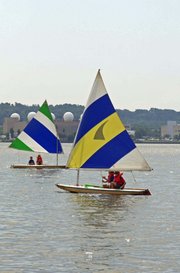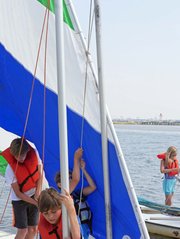It was 9:45 a.m. in early July, and Amy Zang, who lives in Del Ray, was checking in the 141 campers sitting on the lawn waiting for their week of sailing instruction at the Washington Sailing Marina.
Zang has been at the sailing camp for 25 years, the last 20 years as director. This week there are six different levels of classes for kids and on weekends and evenings there are adult sailing courses available. "I have nine coming tonight."
"Listen," she says between the roars of planes taking off from the airport. "Find a partner; meet someone new." The beginning sailors, who will be learning on the Sunfish, walk by in pairs to their 15-minute land lesson with a sail instructor, then slip into their orange life jackets and off to rig the boats. "OK, you put up the jib first." The classes move up to a Flying Scot, then a Hobie Cat.
"We start with the bare minimum — how to steer and turn the boat, how to avoid capsizing and how to right the boat if you do.” Zang says.
On the second lesson they move on to wind direction and reinforcing the parts of the boat. “Once they get a little taste, they get hooked and are willing to listen because they want to know how to make the boat go." She says tacking up wind is probably the hardest thing to learn to do.
Zang answers her walkie-talkie attached to her belt — a check-in on one of the sailors. A staffer needs two more small life jackets and another reports an engine bubble. A maintenance worker stops by to drop off spare daggerboard handles. Then a call in for lunch orders. She says, "This goes on all day long."
Today she says she has a staff of 40 although she has a database to draw on of about 60. She points to a sheaf of papers that makes scheduling a nightmare but gives more flexibility to everyone. "Heather, right behind me, has been here 14 years and Nick, who is director of wind surfing, has been here 15 years. I have all levels of staff beginning with the teenage Counselors in Training (CIT) who can move up with experience. All instructors must complete a 6-hour on-line boat safety training course, CPR and first aid, and an on-water 20-hour training course with me. I spend a lot of time training staff and make them interchangeable to the extent possible. My staff are the face of the camp and they know I love it and what I expect."
Zang says she has a number of youths from Alexandria, but many come from all over the metropolitan area. A number of them come for more than one week and then return the next year. Many are staying with grandma and come while they are here. "Last week I had two campers from Spain. Since there is a large diplomatic presence, we have a big variety." The program has grown since Zang began when camp was offered for six weeks in the summer and averaged 60 youths. Now it is 11 weeks and averages 100 a week. Although this year looks good, she says the economy has taken a toll the last couple of years as attendance fell. And the older teenagers who used to use their pay as extra spending money now rely on it more as a necessity.
Zang is a special education teacher during the school year and says the organization and management skills she learned in teaching have been invaluable. "Knowing how people think is huge." Recently she added, "we had a young girl who was too afraid to go out. So I sat with her. Then a couple of days later, she said she would like to go out with me and I just sailed by the dock. She loved it, got hooked and came back for another week. I work with people." She pointed out that sailing is also good thing for youths with ADHD because the results are immediate; the boat responds or it doesn't, and they want to know why.
It is 12:15 and the boats are back at the dock for an hour lunch break. Lunch is followed by a debriefing about what they learned that worked or didn't from the morning's activities — then back out until 3:45. And as Zang's T-shirt declares, you can't change the wind but you can adjust the sails. "A life lesson,” she says.


